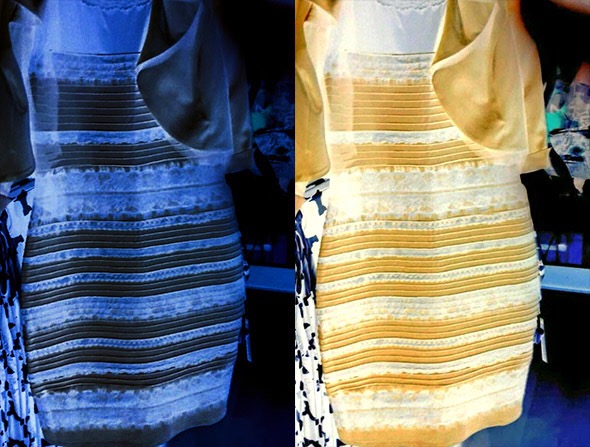Have you ever seen a picture and been utterly convinced of its color, only to be met with bewildered disagreement from others? This was the experience of millions in 2015 when a photo of a dress, seemingly simple, ignited a global debate: was it blue and black or white and gold? This seemingly trivial question about a piece of clothing sparked a storm of scientific explanations, psychological insights, and online discourse, highlighting the fascinating complexities of human perception.

Image: philosophyofbrains.com
Beyond the immediate frenzy, the “dress debate” became a captivating case study in the workings of our visual system, demonstrating how individual differences in perception can lead to vastly different interpretations of the same image. The phenomenon, while initially seen as a mere online curiosity, offered valuable insights into the interplay of light, color, and our brains, ultimately revealing more about ourselves than just the color of a dress.
The Science of Color Perception
What is Color, Really?
To understand why we saw different colors in the dress, it’s essential to grasp the basic science of color perception. Color doesn’t inherently exist. It’s our brain’s interpretation of light wavelengths reflected off objects. Different wavelengths correspond to different colors on the visible light spectrum, from red to violet.
The Role of Light
Light plays a crucial role in our perception of color. The way light sources interact with objects affects the wavelengths reflected and ultimately the colors we see. For instance, under artificial light, objects may appear different than they do under natural sunlight.

Image: www.zenia.com
Individual Differences in Visual Processing
But there’s another crucial factor: each individual’s visual system is unique. Our eyes contain photoreceptor cells called cones, which are responsible for color detection. These cones come in different types, each most sensitive to a particular color range. This individual variation in cone sensitivity contributes to variations in color perception.
The Dress Debate Explained
The Role of Ambient Lighting
One explanation for the “dress debate” centers on the ambient lighting in the original photograph. The photo was poorly lit, and the color of the light source was unclear. Some people interpreted the lighting as warm (yellowish) while others perceived it as cool (bluish). This variation in lighting interpretation led to corresponding variations in the perceived color of the dress.
The Influence of Previous Visual Experiences
Another explanation points to the influence of our previous visual experiences. The human brain constantly compares and contrasts visual information, drawing on its existing knowledge and memories. So, depending on one’s past experiences with light, shadows, and colors, the perceived color of the dress could differ. For example, someone who has spent more time in dim lighting might be more likely to interpret the dress as black and blue.
Adaptive Color Perception
The phenomenon of color perception being influenced by prior experience is closely related to the concept of adaptive color perception. Our eyes constantly adjust to changes in lighting conditions to maintain a stable visual world. This adaptation, while helpful for navigating the world, can lead to discrepancies in color perception, especially in ambiguous situations like the infamous dress photo.
The Power of Perception
The dress debate is a powerful reminder of the active role our brains play in shaping our perceptions. What we see isn’t just a passive reflection of the world; it’s a complex interplay of light, our visual system, and our personal experiences. This realization has implications beyond just understanding how we see color.
The Impact on Social Interaction
The dress debate, despite its seemingly frivolous nature, highlights the potential for perceptual differences to influence our social interactions. Our varied interpretations of the same stimulus can lead to misunderstandings, conflicts, and ultimately, a lack of common ground. This is especially relevant in today’s polarized world, where differing perceptions of reality often fuel divisive narratives.
The Importance of Perspective
Beyond social interactions, the dress debate underscores the significance of recognizing individual perspectives. Not everyone sees the world in the same way, and understanding these differences is crucial for fostering empathy, collaboration, and a more nuanced understanding of the world around us.
Moving Beyond the Dress
While the “dress debate” may have faded from the headlines, its impact continues to reverberate. It serves as a powerful reminder of the limitations of our perception and the importance of questioning our own assumptions. It encourages us to be more mindful of how our experiences shape our understanding of the world, and to appreciate the diversity of perspectives that exist.
What Color Is The Dress Blue Or Gold
The Future of Visual Perception Research
The study of visual perception is a dynamic field continuously exploring the complexities of human vision. As technology advances, researchers are uncovering new insights into the brain’s visual processing, with implications for improving everything from medical diagnosis to artificial intelligence.
The “dress debate” may have been a simple online curiosity, but it sparked a global conversation about the nature of reality, revealing the multifaceted nature of human perception. It taught us that the world we see isn’t always what it seems, and that understanding the nuances of perception is crucial for navigating a complex and ever-changing world.






